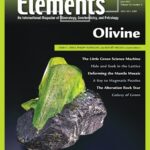
Olivine, June 2023, Vol. 19, No. 3
June 28, 2024
Elements Joint Society Calendar (2025–2026)
July 17, 2024Biomagnetism, August 2023, Vol. 19, No. 4
$20.00
In this thematic issue of Elements, we look into biomagnetism and the production of magnetic minerals by microorganisms. In popular culture, this may have supernatural connotations; however, in reality, there are many microscopic biological organisms possessing magnetic behaviour owing to their formation of magnetic nanoparticles (MNP) such as magnetite (Fe3O4), maghemite (γ-Fe2O3), and greigite (Fe3S4).
Biomagnetism
August 2023, Vol. 19, No. 4
In this thematic issue of Elements, we look into biomagnetism and the production of magnetic minerals by microorganisms. In popular culture, this may have supernatural connotations; however, in reality, there are many microscopic biological organisms possessing magnetic behaviour owing to their formation of magnetic nanoparticles (MNP) such as magnetite (Fe3O4), maghemite (γ-Fe2O3), and greigite (Fe3S4). We look broadly at the relationship between biogenic MNP formation and biomagnetism: focusing on the mechanisms responsible for these minerals by bacteria; seeking to address whether MNP hold clues to the evolution of life on Earth, and potentially beyond; investigating the contribution of biomagnetism to the biogeochemical cycling of iron; considering the potential application of MNP for industrial remediation; and probing the presence of MNP in multicellular prokaryotes and eukaryotic organisms.
Why You’ll Love Elements Magazine:
- Expert Contributors: Articles written by renowned researchers in the field of geoscience.
- Engaging Content: Join a community of readers who are passionate about Elements.
- Exceptional Quality: Each issue is printed on high-quality paper with stunning visuals and detailed illustrations that bring complex scientific concepts to life.
Order your copy of the August 2023 issue of Elements magazine today and explore biomagnetism.
Related products
-
Zircon – Tiny But Timely, February 2007, Vol. 3, No. 1
$20.00Where would Earth science be without zircon? As Earth’s timekeeper, zircon has proven to be a remarkable and versatile mineral, providing insights into deep time and ancient Earth processes. However, there is still much to learn about Earth’s history from zircon and its behaviour.
-
The Nuclear Fuel Cycle – Environmental Aspects, December 2006, Vol. 2, No. 6
$20.00Increasing concerns for the effects of global warming that result from rising greenhouse gas concentrations in the atmosphere have led to a reexamination, even enthusiasm, for nuclear power. Of all the current alternatives to fossil fuels, nuclear fission is the most important source of energy, accounting for 17 percent of the world’s electricity.
-
Water On Mars, June 2006, Vol. 2, No. 3
$20.00During the past several decades, spacecraft data have transformed the planets from astronomical objects into geologic worlds. Mars is the current focus of planetary exploration, and NASA’s objectives for this effort are based on the theme, “follow the water.




